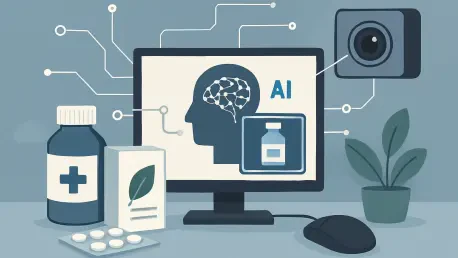Imagine a world where a single social media post could trigger a safety alert for a widely used health supplement, saving countless consumers from potential harm. This scenario is no longer a distant dream but a tangible reality with the emergence of cutting-edge AI tools designed to monitor health product risks in real time. As consumer demand for alternative remedies like cannabis-derived products and dietary supplements skyrockets, traditional regulatory systems struggle to keep pace, leaving dangerous gaps in safety oversight. This market analysis delves into how an innovative AI tool named Waldo is transforming post-market surveillance by tapping into the vast, unfiltered data of social media platforms. The focus is on current trends, data-driven insights, and future projections for health product safety, offering a strategic lens on how digital innovation is reshaping the landscape of public health protection.
Market Trends and Data Analysis in Health Product Surveillance
The Growing Gap in Traditional Safety Mechanisms
The health product market, particularly for less-regulated categories such as dietary supplements and cannabis derivatives, has expanded dramatically in recent years. Consumer interest in natural and alternative therapies has surged, yet oversight remains limited compared to prescription drugs or medical devices. Traditional adverse event (AE) reporting systems, often reliant on voluntary submissions from healthcare providers or manufacturers, fail to capture a significant portion of real-world harms. Data suggests that many incidents go unreported, creating a blind spot for regulators and leaving consumers vulnerable. This gap underscores a critical market need for innovative solutions that can address the shortcomings of conventional surveillance and adapt to the fast-evolving health product sector.
Social Media as an Untapped Data Goldmine
Social media platforms have emerged as a powerful, albeit unconventional, source of consumer feedback, with millions of users sharing personal health experiences daily. Platforms like Reddit host candid discussions about product effects, ranging from mild discomfort to severe reactions, providing raw data that traditional systems often miss. Recent analyses reveal that an AI tool like Waldo can process vast amounts of unstructured text from such platforms with remarkable accuracy, identifying potential AEs at scale. For instance, in a comprehensive test involving over 437,000 posts related to cannabis-derived products, nearly 29,000 potential harm reports were flagged, with a high validation rate upon closer inspection. This trend highlights the untapped potential of user-generated content as a real-time safety net, offering a dynamic complement to static reporting mechanisms.
AI Precision Outpacing Generic Solutions
Delving deeper into market dynamics, specialized AI tools are carving out a competitive edge over general-purpose technologies in health surveillance. Unlike broad AI models that falter with the nuanced language of health discussions, tailored machine learning systems are proving far more effective. Waldo, for instance, achieves near-perfect accuracy in detecting AEs, significantly outperforming human annotations and generic chatbots. This precision positions specialized AI as a cornerstone of future market growth in digital health monitoring, with the potential to expand across diverse product categories. However, reliance on singular data sources like Reddit poses risks of incomplete market representation, signaling a need for broader platform integration to ensure comprehensive insights.
Future Projections for AI-Driven Health Safety
Scaling Digital Surveillance Across Platforms
Looking ahead, the trajectory of AI in health product surveillance points toward widespread adoption and platform diversification. Current trends suggest that tools like Waldo could extend beyond Reddit to analyze data from visually driven platforms such as Instagram or short-form content hubs like TikTok, where health trends often gain traction. Projections indicate that by integrating multi-platform data from 2025 to 2027, the accuracy and reach of AE detection could increase by significant margins, capturing a more diverse consumer base. This expansion aligns with growing market demand for real-time safety insights, potentially influencing regulatory policies and industry standards on a global scale.
Economic and Regulatory Impacts on Market Growth
Economically, the low cost of scaling digital surveillance tools presents a compelling case for market adoption. Unlike labor-intensive manual reviews, AI-driven systems offer a cost-effective means to monitor vast datasets, making them attractive to both private companies and public health agencies. On the regulatory front, there is an anticipated shift toward incorporating AI insights into formal oversight frameworks, with potential mandates for health product manufacturers to integrate social media monitoring into safety protocols. However, evolving data privacy laws could pose challenges, requiring market players to balance innovation with compliance. These factors collectively forecast a robust growth curve for AI tools in health safety over the coming years.
Collaborative Innovation through Open-Source Models
Another pivotal projection centers on the role of open-source technology in driving market collaboration. By making advanced tools freely accessible, the industry can foster a collaborative ecosystem where stakeholders ranging from researchers to regulators contribute to refining surveillance capabilities. This democratization of technology is expected to accelerate innovation, with customized AI models tailored to specific health markets or regional needs likely to emerge. The open-source trend also mitigates entry barriers for smaller market players, enhancing competition and spurring advancements that could redefine safety monitoring standards across the health product sector.
Reflecting on Strategic Implications
Looking back on this analysis, the integration of AI tools like Waldo into health product surveillance marked a transformative shift in how market risks were identified and addressed. The ability to harness social media data with high precision offered a lifeline where traditional systems fell short, reshaping industry approaches to consumer safety. Strategic next steps involved investing in multi-platform AI capabilities to ensure broader market coverage and address regional disparities in data representation. Additionally, forging partnerships between tech developers, regulators, and health product companies became essential to navigate privacy concerns and embed digital insights into actionable policies. Encouraging responsible consumer engagement online also emerged as a vital consideration, empowering users to contribute to safety databases knowingly. These steps, grounded in collaborative and innovative thinking, laid a foundation for a safer, more responsive health product market in the years that followed.









